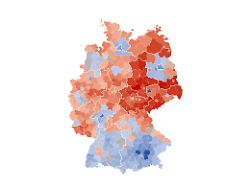development of the population
How Germany will change by 2040
By Martin Morcinek and Christoph Wolf
4/21/2023 8:33 p.m
The forecasts for population development do not bode well: the average age is rising, entire regions are threatened with aging – with consequences for politics, planning and real estate prices. Where is demographic change hitting particularly hard?
The year of the forecast sounds like a long way off, but in fact there are only seventeen and a half years left until 2040: If the forecasts from the Federal Office for Research on Building, Urban Affairs and Spatial Development (BBSR) are correct, then Germany will change dramatically across the board.
A look at the Germany map for the population forecast shows the regions in which the Bonn office expects particularly significant changes:
According to the current spatial planning forecast, the average age in Germany is likely to continue to rise. At the same time, experts anticipate that the number of children will fall and the working-age population will shrink. The forecast is based, among other things, on official data on population development. Since the early 1970s, the number of newborns in Germany has been below the annual number of deaths.
The Federal Office’s assessment has far-reaching consequences for politics, the labor market and urban planning. Regions with declining populations face significant challenges. This ranges from practical questions in regional and municipal administration to price developments in property and real estate markets.
However, not all regions in Germany are equally affected by the developments outlined. According to the forecast, an increase in the population is more likely to be expected in the economically stronger areas in the west and south of the republic. The cities and regions around the German metropolises should therefore benefit in particular.
Structurally weak areas in the east or in parts of Saarland and the Palatinate, on the other hand, are confronted with growing problems: How many school and day-care places should the municipalities provide there? What about long-term investments in public infrastructure? For which population numbers should sewers, local transport systems and nursing homes be designed. And: How will the regional demand for living space change?
“Demographic change is having a variety of effects on the economic development of the regions and on regional services of general interest,” says the Bonn office, summarizing the changes that are emerging. With the spatial planning forecast, the authority tries to estimate regionally how the population figures could develop in the future – on the basis of the data available so far.
However, it is still unclear which regions will actually grow or shrink in the coming years – as predicted: the trends that are emerging are obviously not set in stone. It is said that whether the population of a region decreases or increases does not only depend on births and deaths or the number of people moving in and out.
Factors that are difficult to predict or highly variable, such as immigration from abroad, structural changes locally or the settlement of successful companies, could influence local conditions. The forecast expressly does not cover such factors. The effects of ongoing or planned political measures are also not recorded: support programs and similar decisions could turn the local trends. Such control attempts have not yet been included in the forecast up to 2040.
